Most Dangerous Apps for Kids 2024: What Parents Should Do
Even if you know which apps to look for, checking your kid’s phone isn’t always a viable option. The kids can hide the apps in different folders or download apps to hide or change the display name of an app. Then, with a single tap, they can invite predators, identity thieves, cyberbullies, porn, drug dealers, and more into their lives. Many of these apps are well-known and considered “safe,” while others have generic sounding names that don’t indicate their potential dangers.
The best we can do is to install a parental control app that will monitor the child’s phone and track all apps that are installed, whether it’s through the official app stores or as a direct download.
After testing more than 30 parental control apps, Bark proved to be the best. It lists all apps that are installed on my child’s phone and has links to trusted sources with information about the apps, which is extremely helpful if I was not familiar with the app.
Best of all, Bark has a 7-day free trial, so you can experience its app monitoring and blocking features firsthand.
Short on Time? Here’s How to Keep Your Kids from Dangerous Apps in 2024
- Stay informed: It’s important for parents to stay updated with the latest dangerous apps, viral trends, and online slang kids are using. Start by looking through the list of the 10 most dangerous apps listed below, and then become familiar with other trusted parental sources.
- Install a parental control app: Getting a parental control app makes it much easier to monitor what apps are installed on your child’s phone, and it gives you the tools needed to block or restrict them. Bark outperformed more than 30 premium parental control apps I tested with its powerful features and you can try it free for 7 days!
- Block or limit the apps: Some apps are only dangerous when they’re used unsupervised, and others should be blocked and deleted immediately. Using an app like Bark will give you the tools needed to manage these dangerous apps in the best way you see fit.
Potential Risks: 10 Most Dangerous Apps for Kids in 2024
While there are different types of dangers associated with apps, including spyware, backdoor vulnerabilities, and identity theft risks, this section will focus on apps that are specifically geared towards kids and carry potential dangers related to unsafe social media usage and inappropriate content. It is crucial for parents and guardians to be aware of these risks and take proactive measures to protect their children from the potential harms posed by these apps.
- Whisper: The anonymous nature of Whisper can make it difficult to monitor interactions, increasing the risk of cyberbullying, grooming, and exposure to harmful content that can negatively impact a child’s well-being and mental health.
- TikTok: Along with potential privacy concerns, TikTok’s algorithmic content recommendation can expose children to inappropriate or age-inappropriate content, while challenges and trends may encourage risky behavior and mimic dangerous stunts, posing physical harm risks.
- Omegle: As a platform with no age verification, Omegle can expose kids to explicit sexual content, online predators, and individuals with malicious intentions, leading to potential psychological and emotional harm.
- Yubo (formerly Yellow): While Yubo claims to be a platform for making friends, the lack of stringent user verification can make it easy for predators to create fake profiles and exploit young users, putting children at risk of grooming, harassment, or manipulation.
- Live.me: The live streaming aspect of Live.me enables users to broadcast themselves publicly, which can make children vulnerable to inappropriate requests, comments, and harassment from strangers.
- Kik: Kik’s anonymous messaging feature and the ability to join public chat groups can expose children to explicit content, cyberbullying, and potential encounters with online predators posing as peers.
- Snapchat: With its disappearing messages, Snapchat can facilitate the sharing of explicit photos or videos, cyberbullying, and the deceptive nature of “Snapstreaks” can lead to excessive and addictive use of the app, impacting a child’s mental well-being.
- Holla: Random video chat matching on Holla can expose children to adult content, inappropriate behavior, and even instances of sexual harassment, creating an unsafe online environment for young users.
- MeetMe: The location-based matching feature of MeetMe can lead to face-to-face meetings with strangers, posing potential risks of physical harm, exploitation, or abduction.
- Calculator (Secret Photo Vault): Apps like Calculator provide a deceptive way for children to hide photos or videos that may involve explicit content, increasing the risk of inappropriate sharing, blackmail, or unintended exposure.
Next Step: Protect Your Kids From the Most Dangerous Apps in 2024
Knowing what apps your child has installed on their phone is crucial for their safety and privacy. The challenge arises when children hide these apps in folders or use ‘disguised’ apps, making them difficult to find or recognize. It’s not enough to just physically check their phone; a more advanced and reliable solution is needed.
A parental control app serves as a smart solution to keep you informed about your child’s digital activities, especially with respect to the apps they use. Through these apps, you can see exactly what’s installed on your child’s phone, even if they’ve attempted to hide or disguise certain apps.
Not only can you monitor what’s installed, but these apps often provide comprehensive reports about usage—how often and when certain apps are used. Some also allow you to block or limit usage of specific apps, ensuring your child’s digital experience is both safe and balanced.
After evaluating more than 30 parental control apps, I found that Bark outperforms the rest in terms of functionality and ease of use. It keeps an updated list of every app installed on the phone, includes data on many of them, and monitors interactions on over 30 social media and email apps. Bark has a 7-day free trial, so you can try it for yourself risk-free.
3 Best Parental Control App for Monitoring and Blocking Dangerous Apps in 2024
1. Bark: Sends Real Time Alerts When Dangerous Apps Are Installed on the Child’s Device
- Compiles a list of all installed apps
- Reports include app ratings and links for more information
- Block or allow different apps, based on the time of the day
- Monitors interactions on more than 30+ social media and email apps
- Try Bark free for 7 days!
After testing more than 30 different apps, I can confidently say that Bark is the best method I have come across for identifying and taking action against dangerous apps installed on a child’s phone. With its powerful features and comprehensive monitoring capabilities, Bark provides parents with the tools they need to ensure their child’s online safety.
One standout feature of Bark is its ability to send alerts whenever a dangerous app is detected on the child’s device. The alert includes a short introduction about why the app is considered dangerous and risky and a button to click if you want more information about the app. I appreciated this feature as it made it easier for me to find out information about apps that I don’t recognize or understand why they’d be considered dangerous.
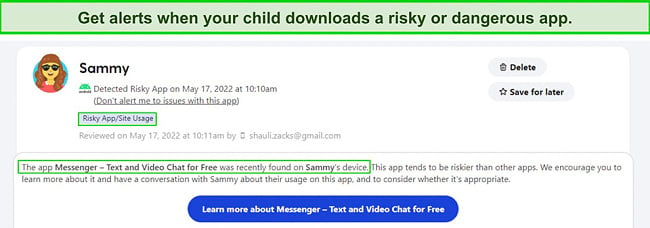
The Bark Insights section on the parental dashboard maintains an updated list of all the apps that my son installed on his phone, even if they were deleted. The apps are divided by age rating, making it easier to focus on the mature or teen-rated apps.
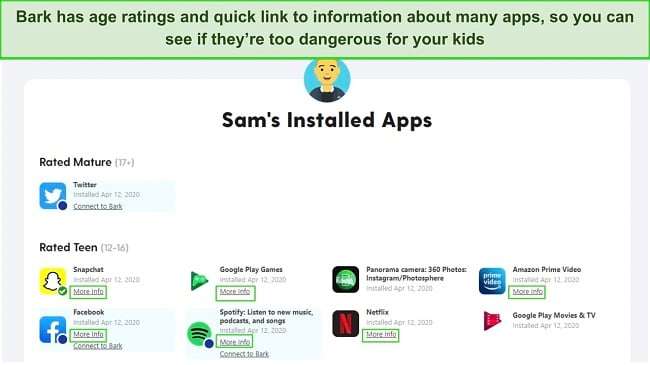
While Bark doesn’t show me how much time my son uses each app, there is a custom screen time routine that allows me to choose when each app is available. There are four sets of rules named default, free time, bedtime, and school time, and I can choose what apps or app categories are available at these times. This way, I can block really dangerous apps at all times and give permissions to apps that are only dangerous if a child is using them without supervision.
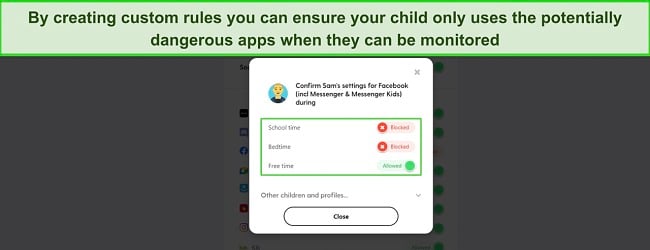
One of Bark’s top features is how it connects with over 30 social media and email apps and uses AI and machine learning to monitor them for inappropriate conversations, pictures, and comments. This is an extremely valuable tool for helping to determine whether your child uses an app in a safe or dangerous manner. If it detects dangerous activity, it will upload the offending content to the parental dashboard and include the category tags that were triggered.
You can try Bark free for 7 days, which should give you enough time to see what apps are installed on your child’s phone and see if they’re using the apps in a dangerous manner.
2. Qustodio: Lists Every App Used on the Child’s Device and Includes Comprehensive Monitoring Tools
- Block dangerous apps or set time limits to prevent overuse
- Create a screen time calendar to monitor your child’s app usage
- Detailed reports include information on how much time each app is being used
- 30-day free trial with no credit card required!
If you’re more concerned about blocking apps than getting alerts and quick information about them, then Qustodio is another app that performed really well in my tests for how it handles dangerous apps. It provided complete control over my son’s apps usage, including when and for how long he could use each of them. A standout feature of Qustodio was its ability to prevent my son from bypassing, disabling, or deleting the app without sending me an alert.
All apps are listed in the Games and Apps section as soon as they are opened. This ensures that even if my child tries to hide an app in a cluttered folder, use an app vault, or employ other methods to conceal it, I will still be aware of its presence on his phone. With countless apps available online, individually screening each one would be impossible, but reviewing the list of apps my son uses allows for a quicker and easier process. If I notice dangerous apps or unfamiliar ones, I can do some brief research and take appropriate action.
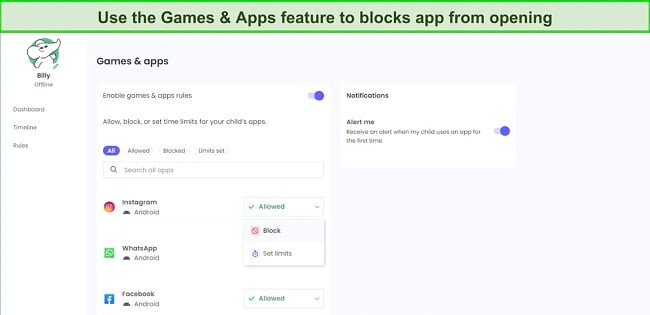
The most effective measure against dangerous apps is to block their opening. If my son attempts to access a blocked app, the Qustodio lock screen will cover his phone, informing him that he cannot access the app for his own safety.
For apps related to screen time addiction, I can set specific time restrictions, preventing excessive or inappropriate usage. By setting boundaries on the amount of time my son can spend on certain apps, I can promote healthy screen habits and maintain a balance between digital and offline activities.
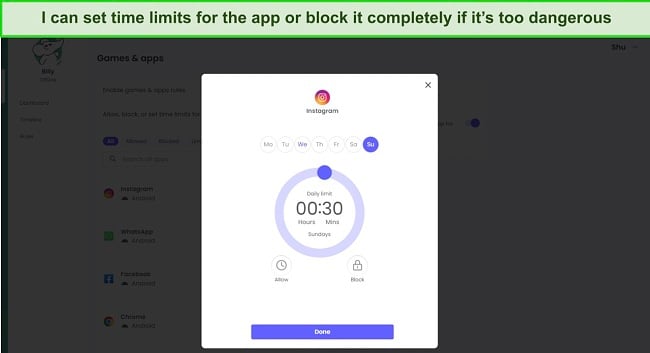
In the case of apps that I’m not sure about, I utilize the Restriction Calendar feature. This gives me the flexibility to specify the times when my son can use the app. This way, I can allow him to use it only when a parent is present to ensure he is not engaging with inappropriate individuals, sharing personal information, or participating in dangerous challenges or trends.
Qustodio also provides detailed reports that indicate the amount of time my son spends on each app. These comprehensive reports offer valuable insights into his app usage patterns, enabling me to identify any potential concerns or excessive usage. By understanding his app preferences and habits, I can identify potentially dangerous apps that may have otherwise gone unnoticed and take proactive measures to prevent any issues from arising.
Additionally, Qustodio offers a 30-day free trial without requiring credit card information. This allows you to explore and experience the features and benefits of Qustodio firsthand, ensuring that it meets your specific needs before making a commitment.
3. Norton Family: Monitors Which Apps are Installed and How Often They are Used
- Block dangerous apps from opening
- Tracks app use for up to 30 days
- 30 day free trial!
Norton Family is another app that performed well in my tests for detecting dangerous apps. It has an easy-to-use parental dashboard that lists all installed apps on the child’s phone. However, unlike Bark, it won’t send an alert when dangerous apps are installed, but at least I can check the list and see if there are any apps that I consider dangerous.
Norton Family has an app blocking feature, which allows me to prevent my son from using any dangerous app. The lock screen that prevents the app from opening has a link where the child can request access. This is a good way to initiate a conversation with your child about why you’re blocking the app and explain what makes it dangerous.

There are two screen time features, a general daily limit, and a usage calendar, but no option to set separate rules for individual apps. So, I couldn’t limit how long my son uses a specific app or only give him access to it when a parent was home unless I blocked the entire phone.
The reporting can track app use for up to 30 days. I found this helpful for apps that are okay when used in short doses or under supervision but can be dangerous when my son is spending hours each day on the app. By viewing these reports, I know whether I need to block these apps or if my son is using them responsibly.
Norton Family has a 30-day free trial. While you will need to enter your credit card to activate the account, you won’t be charged until after the free trial ends.
FAQ
Can I block my child from downloading dangerous apps?
How do kids hide apps that they download?
Why are social media and messenger apps considered dangerous?
Only a Premium Parental Control App Can Block Dangerous Apps
While checking which apps your child downloads on their phone can feel like an impossible job, with the right tools, it’s really quite easy. By using a premium parental control app that your child can’t easily disable, it will monitor all app downloads, so your child can’t disguise or hide them from you. They also give you the ability to block or set limits on the apps, so you can help create a safe and healthy online environment.
After testing more than 30 parental control apps, Bark proved to be the top choice for monitoring dangerous apps. It sends an alert when a dangerous app is downloaded, creates a list of apps installed on the child’s device, and can place time restrictions or block the app completely. Bark comes with a 7-day free trial, which gives you the opportunity to test it on your child’s phone risk-free.

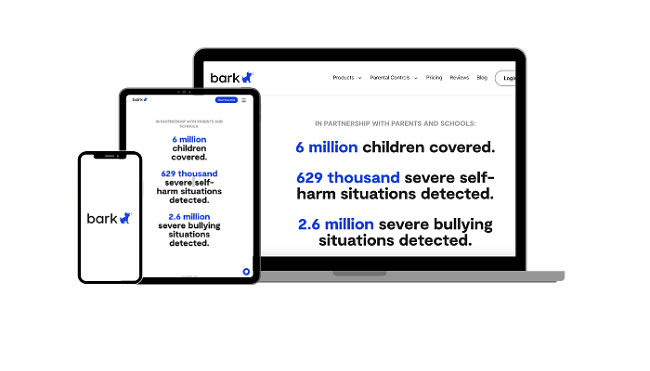
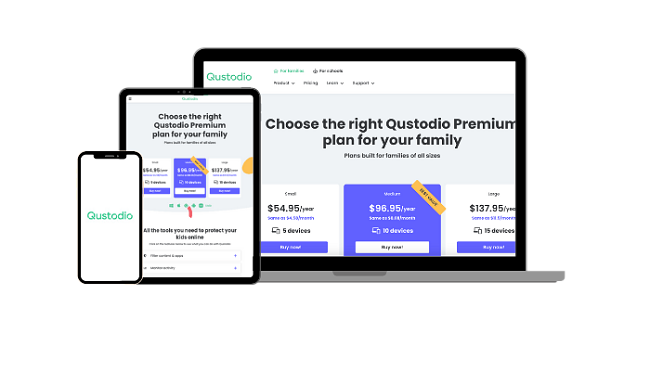





Leave a Comment
Cancel